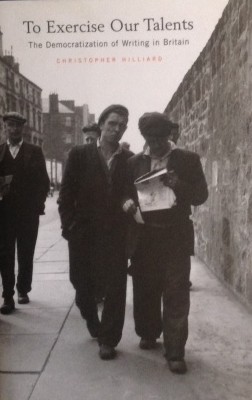Inspiring Older Readers
 posted on 21 Feb 2017
posted on 21 Feb 2017
To Exercise Our Talents : The democratization of writing in Britain by Christopher Hilliard
This is one of those very rare things – a book that is both a remarkable piece of literary research and an accessible and enjoyable read. Hilliard set himself quite a daunting task in trying to uncover hidden or undervalued writing by writers who struggled to find an audience or develop a profile but he has produced an impressive body of work that is utterly convincing.
Looking back to the early part of the twentieth century Hilliard’s starting position is to acknowledge that being a successful writer was a matter of social class and income. He cites Virginia Woolf’s famous dictum of the need for a creative spirit to have access to a ‘room of one’s own’ and Cyril Connolly’s assertion that the enemy of the creative impulse was ‘the pram in the hallway’ and he notes:
Readers of literary biographies will be familiar with the social advantages that usually preceded a successful writing career in Britain during the first half of the twentieth century.
However, he goes on to assert, this is not a true reflection of the scale, scope and nature of writing that was being done and submitted for publication. What Hilliard proposes is that amongst the middle, lower middle and working classes there was a substantial writing culture that rarely made it to publication or public attention and that was, by definition, difficult to track but was, nonetheless, important.
He starts off by tracing the rise of the writer’s correspondence colleges and self-improvement courses that advertised themselves as preparing aspiring writers to submit stories to the burgeoning magazine market and to newspapers that were regularly publishing short stories at this time. This was largely a middle class or lower middle class preoccupation although creative writing also became a feature of working class educational initiatives like the WEA or The Plebs League.
For me, however, this study really takes off and begins to uncover some genuinely fascinating material when Hilliard turns his attention to the phenomenon of working class authors during the inter-war years. The 1930s is often seen as the ‘golden era’ of working class or proletarian literature and this study rightly draws attention to way in which working class writers were either happy to accept the sponsorship and mentoring of established middle class writers, editors or publishers or those who were determined to preserve the independence of their class endeavour; as Leslie Halward insisted, he wanted to write about his own people in their own language.
Hilliard moves on to consider how the Second World War affects the nature of the writing being produced by ‘ordinary’ people and how ‘during the war, working class authors associated with the 1930s mingled with other young writers, both socially and on the pages of new little magazines.’ He focuses particularly on the example of the magazine called Seven – which I must admit I’d never heard of before. You can get a feel of what this publication was like from this early editorial:
This volume is entirely the work of people, like yourselves, who earn their living at jobs other than writing or drawing, and of youngsters. …Writing is not the special preserve of a select few. You can write too. You can draw too….all who can think can write.
Hilliard also briefly tries to address the often talked about question of why the Second World War didn’t produce poets of the same quality as those that emerged from the First - Brooke, Owen or Sassoon for example. I think he shows pretty conclusively that there was in fact plenty of poetry being written but it was in the context of a much wider and more diverse literary output than had been witnessed in the 1914-18 war. Whatever its impact on the literary canon he says, the Second World War mobilized many British people to write….Some found a niche writing to hearten or entertain their comrades…others were moved to write poetry by their war experiences, acting on a different aspect of popular romanticism.
As we move into the late 1950s and early 1960s, Hilliard traces the path of working class writing and says, perceptively I think, that one of the big changes that we see is the refusal of working class authors to be constrained into seeing their class status as the only topic for their writing. Stan Barstow, Alan Sillitoe or Arnold Wesker refuse to be typecast or constrained in their subject matter.
This thoughtful and assiduous piece of research has introduced me to writers and publications that were entirely new to me and I love being given these new threads to follow and track down for myself. If you’re into this kind of literary archaeology you’ll love it too.
Terry Potter
February 2017